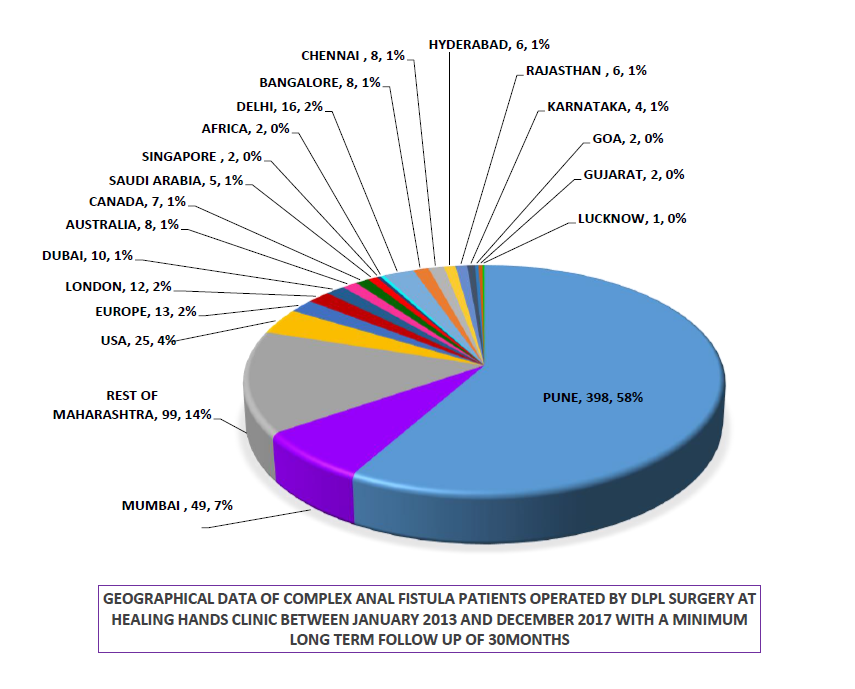
Long-term follow-up of 683 operated patients shows a 99% success rate
Whether he would lose bowel control was one thing that weighed heavily on Ankit’s mind prior to undergoing surgery for anal fistula. “It has been more than two years now. I am completely fine post-surgery,” said Ankit, a software professional.
Ankit was part of an observational study comprising long-term follow-up of 683 operated patients with complex anal fistula for 30 months.
The study has shown that a minimally-invasive laser surgery technique can cure patients with complex anal fistula without causing bowel/anal incontinence – a known postoperative complication. The surgical technique also significantly reduces the recurrence rate which is very high in patients with anal fistula.
“Anal fistula is often considered a dilemma because of postoperative incontinence and recurrence rate. Using a distal laser proximal ligation technique (DLPL) – a minimally invasive sphincter-saving surgery, we could address anal incontinence and recurrence in 99% of our operated patients,” said Pune-based colorectal surgeon Dr. Ashwin Porwal.
Dr. Porwal’s study got published in a reputed index journal – Indian Journal Of Colorectal Surgery – recently.
Patients with anal fistula harbor apprehension of developing anal or bowel incontinence post-surgery. The bowel incontinence ranges from an occasional leakage of stool while passing gas to a complete loss of bowel control. It can significantly impact the quality of life.
“The goal of the surgery is a balance between getting rid of the fistula while protecting the anal sphincter muscles, which could cause incontinence if damaged. The DLPL technique deals with the root cause of complex fistula that is the internal opening and inter-sphincteric abscess,” Dr Porwal said.
DLPL is specifically designed for highly complex anal fistulas. “That’s why it has a 99 % success rate even in patients with type 4 complex anal fistula,” Dr. Porwal said.
Core principles of the DLPL technique are accurate diagnosis based on a 3D endoanal imaging probe, adequate debridement of the fistula tract with a radial Laser fiber, efficient drainage of the abscess in the first three weeks post-surgery, and excellent post-operative wound care.
“Follow-up after surgery is the key to success. A minimum of three follow-ups are required. First at 2nd week, then 5th week and finally at 8 weeks,” he said.
When probed why the study did not compare DLPL results with other laser treatments meant for anal fistulas, Dr. Porwal said, ” Ours is the only published study till date on highly complex anal fistulas with use of laser. Most of the studies – available for laser treatment in fistula – are for moderate cases but not specific to type 4 or highly complex cases.”
Every study has certain limitations. “In our case, it was a single-center study. But very soon we are planning to do a multiple center study. Adequate training of the surgeons is a must before that,” Dr. Porwal said, adding, “To date, we have operated on more than 5,500 cases of complex fistula. Very soon we will be publishing the results of our long-term follow-up study of operated patients for five years.”
Dr. Jaya Maheshwari, a senior member of the Indian Association of Gastrointestinal Endosurgeons (IAGES) Jaipur was the first surgeon outside Pune to get trained under Dr. Porwal in 2014. “I have performed DLPL technique on more than 200 patients with highly complex anal fistula by now with a similar success rate of 98-99 %,” Dr. Maheshwari said.
BOX
Why the study?
The surgical management of complex fistula carries a greater risk of incontinence, due to the involvement of the anal sphincter muscles
There are many surgeries performed for complex anal fistulas, but their success rates are variable
There is no single technique that can be called a gold standard in managing complex cases
The surgery with good-postoperative healing, with minimal or no functional loss, and less recurrence is need of the hour
This study was conducted to evaluate the efficacy of a novel technique, DLPL surgery, in the treatment of complex anal fistula
This study aimed to objectively assess the impact of operative treatment using the DLPL technique on quality of life-related to anal incontinence, recurrence
The study design
The study Included 683 operated patients of highly complex anal fistula with the DLPL technique between January 2013 and December 2017 with a minimum long term follow up of over 30 months
Most of the patients were working in the IT industry
Most of the patients were discharged the next day of surgery
The average time required to resume normal activities was less than a week
The overall success rate of the DLPL technique was 98.98% with a minimum long-term follow-up period of 30 months
Complete healing time was average 10 weeks for most of the cases
The study has concluded that the DLPL technique is minimally invasive,sphincter-saving, and has a negligible recurrence rate


